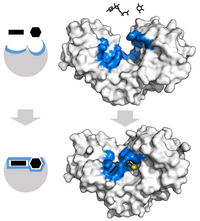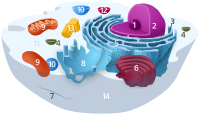Wikipedia:Wikipedia Signpost/2015-05-20/WikiProject report
Appearance
WikiProject report
Cell-ebrating molecular biology

This week, we had the pleasure of interviewing WikiProject Molecular and Cellular Biology, which has come a long way since our last interview in 2008. Like most projects, it has a long member list, but only a small subset of that group regularly contributes. With 28 featured articles and 58 top-importance start class ones, the project has clearly had some success, but has a ways to go. We talked to three regular project contributors.
- Q: Biology is obviously an area of considerable academic study, and many students likely use Wikipedia articles at least for background research. How does the project work to make articles accessible to these types of readers?
- A:
- I usually think of the audience for an article within the project's scope as undergrads taking a relevant class. Obviously very general articles are written for a broader audience and very specific ones, like those on individual proteins, can be much more technical. Recent work on some of the fundamental articles has involved integrating citations to textbooks in the NBCI bookshelf, which are older editions of commonly used college-level textbooks that have been made publicly available online. Using high-quality online sources designed to be introductory as references for basic material gives readers an accessible entry point into the topic. Opabinia regalis (talk) 05:14, 10 May 2015 (UTC)
- For science articles, I think that diagrams are often integral to understanding the topic. My editing focus has been on generating and updating key images. We're lucky to have a number of people with experience in scientific illustration associated with the project. T.Shafee(Evo﹠Evo)talk 10:50, 12 May 2015 (UTC)
- There is a hierarchy of articles from the top importance "core" articles such as gene and protein that are likely to be of interest to a wide audience to the very specialized with much more restricted audiences. Obviously it is important that general articles be written in a way that can be understood by everyone and to a large extent, I think we have achieved that with many of the top importance articles. In order to maintain the readability of the core articles, we try to move more technical details to more specialized articles. Regardless of how specialized an article is, we also try to keep its lead sentence dead simple so that anyone can understand at least what the subject and scope is. Boghog (talk) 10:35, 14 May 2015 (UTC)

- Q: The main project page notes, A primary goal of this project is to collect and organize the totality of this information and make it accessible to researchers and laypeople alike by providing an entry point to the wealth of biological data that is currently hidden in obscure databases and journal articles. What advice would you have to other projects seeking that same accessibility?
- A:
- I think the project has been very successful in this, though others can speak in more detail about the Gene Wiki articles, Pfam integration, and related efforts. The biology and biochemistry research community has seen a significant shift over the last decade toward open access for the products of government-funded research, which means that much of this work is no longer behind paywalls maintained by journal publishers. When writing articles I generally prefer to cite papers that are freely available, and ideally those that are published in open-access journals; I'd like to see that preference adopted more broadly by other projects, both as facilitating verifiability and as support for fellow-travelers in the broader free knowledge movement. I'd also like to see progress Wikipedia-wide toward the goals of WikiProject Open Access in systematically identifying and highlighting OA sources. Opabinia regalis (talk) 05:14, 10 May 2015 (UTC)
- One of the most effective ways of making accessible information that hidden in obscure databases are external links in infoboxes such as the {{GNF Protein box}}, {{Infobox protein family}}, and {{Infobox enzyme}}. In addition, we have coordinated with several of these external databases such as GeneCards and IUPHAR to provide reciprocal links back to the appropriate MCB articles so that these are now integrated into a larger web of scientific information that extends beyond Wikipedia. Another way of making technical information more accessible to specialists in through navboxes, for example {{G protein-coupled receptors}}, {{Ion channels}}, and {{Transcription factors}}. The hierarchy contained in these navboxes allow specialists to quickly drill down to the specific articles of interest and to navigate between closely related articles. Boghog (talk) 11:02, 14 May 2015 (UTC)
- Q: Again noting that biology is an area of academic study, there are obviously academics who could be subject-matter experts. In your experience, do any contribute to your project? As an individual editor, would you support allowing academics to "cite themselves" as experts in the field?
- A:
- I think most of the active contributors could be considered subject-matter experts and we'd love to have more. The second question is hard to parse - I'm not sure what you mean by "allowed". By whom, for what? Many editors don't reveal their real-life identity; it's not practical to verify those who do; it's nosy to watch a prolific contributor's edits for evidence of self-citation; and even things that aren't "allowed" are sometimes allowed anyway. We do sometimes see new editors introducing citations to their own papers in articles where they're not really pertinent, but that's usually a good-faith misunderstanding. Obviously everyone should exercise discretion in citing their own work. I think you might be referring instead to experts using their own expertise as an argument in their favor during a content dispute - a practice that had a substantial role in the Essjay controversy some years ago. I was firmly on the record then as opposing any attempt to police content discussions in this way, and I have not changed that opinion. Opabinia regalis (talk) 05:14, 10 May 2015 (UTC)
- I've seen some self-citation of an editor's own published journal articles on wikipedia pages. I think that it's probably a special case of conflict-of-interest though. Scientists are used to adding conflict-of-interest statements to the ends of journal articles and it might be worthwhile making COI disclaimers in edit summaries and on talk pages more common so that everything is out in the open. Even if it's just a sentence or two, it gives other editors the chance to check that the added citation is appropriate and review edits if necessary. T.Shafee(Evo﹠Evo)talk 10:50, 12 May 2015 (UTC)
- Self citation is definitely an issue that we frequently deal with. While editing is anonymous, there are obvious tell tale signs of self promotion, for example adding the same citation to many articles with little or no accompanying content. On the other hand, these are experts in their fields who would be extremely valuable as content contributors. Hence we encourage them to add more content and to include the most relevant highest quality citations. Excessive self citation is frowned upon in scientific journals. Wikipedia is no different. Boghog (talk) 11:16, 14 May 2015 (UTC)
- Q: The collaboration of the month appears to be defunct. In what ways do contributors to the project collaborate?
- A:
- These days most collaborations emerge organically when editors find articles of mutual interest to work on. Sometimes an external event is a trigger (see the featured article review for enzyme), but mostly it's an informal arrangement. The collaboration of the month was helpful in its time, when it had an active organizer, but in retrospect a month is too short for people with busy offline lives to work a substandard article into a viable FA or even GA candidate. There is currently unofficial agreement to clean up the gene article, and that's been going on for almost six weeks on and off with work still left to do. There's some overlap in both content and participation with WikiProject Medicine, which is very active, so some collaborative efforts are organized there as well. Opabinia regalis (talk) 05:14, 10 May 2015 (UTC)
- The main hub of activity is probably the project's talk page since other parts of the project have faded since the project's peak activity. Just the announcement that the enzyme and gene articles were in need of overhauls attracted a dozen or so contributors. Hopefully this pattern will continue as the focus of the community drifts around some of the vital articles. T.Shafee(Evo﹠Evo)talk 10:50, 12 May 2015 (UTC)
- As with most of Wikipedia, active participation in the MCB project has fallen considerably from its peak and hence it is more challenging to attract a critical mass of editors to work collaboratively on any one article. However from time to time, we are galvanized into action to preserve the quality of the project's featured and good articles. In addition, there certain topics such as the CRISPR gene editing technology or the ENCODE gene expression project that have generated a lot of recent controversy that is widely covered by the popular press. Unfortunately this coverage is sometimes distorted and these distortions make their way into the Wikipedia articles. By highlighting these controversies on the projects talk page, we attraction attention from MCB project editors and subsequent flurry of edits to make sure that the contents of the articles are both accurate an maintain a neutral point of view. Boghog (talk) 11:32, 14 May 2015 (UTC)

- Q: How could a new editor contribute to your project right away?
- A:
- There's a few related content areas where we still have patchy coverage:
- Non-human proteins (we have excellent coverage of the human genome and proteome, but those without a homolog in humans have weaker coverage).
- Experimental and computational techniques - this is a topic area where a subject-matter expert could make very substantial contributions with relatively minimal Wikipedia experience.
- Bacterial species, especially non-pathogens.
- Biologists and biochemists, especially women. There are lots of red links in the biology sections of the list of members of the National Academy of Sciences, and on the WikiProject Women scientists worklist.
- Editors who are new to the topic area would benefit from reading WP:MEDRS, the sourcing guidelines for medical and health content, which of course also apply to such content in articles on basic science topics. Opabinia regalis (talk) 05:14, 10 May 2015 (UTC)
- There's a few related content areas where we still have patchy coverage:
- There are a considerable number of red links on protein family articles (see for example Solute carrier family). An external tool is available that automatically creates a Wikipedia stub that can be expanded by editors interested in these particular proteins. This tool considerably lowers the activation barrier for new editors to create new protein articles. The "clinical significance" section of these articles (for example, the diseases caused by mutations in the particular gene) is probably of the most wide interest. Hence expansion of these sections is especially important. Boghog (talk) 11:49, 14 May 2015 (UTC)



Discuss this story
A quick note: editors seeking access to journal articles or other resources should check out The Wikipedia Library, which provides database access for editing purposes. Gamaliel (talk) 23:27, 20 May 2015 (UTC)[reply]